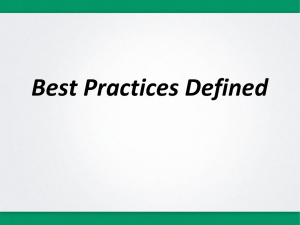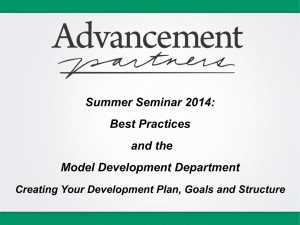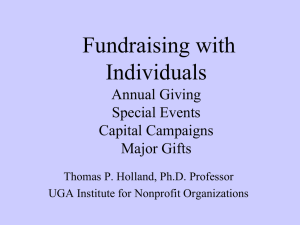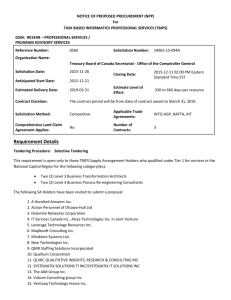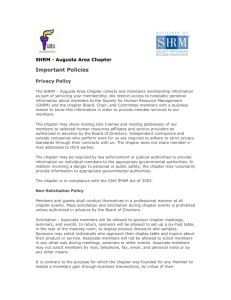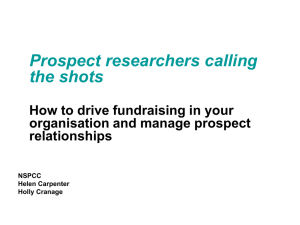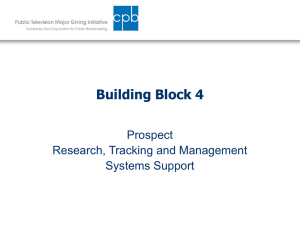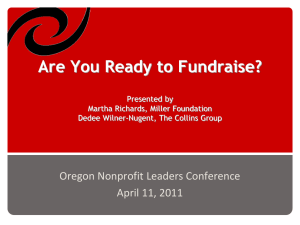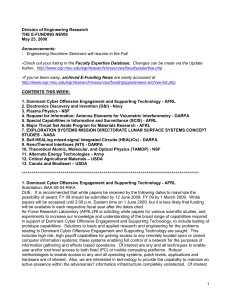SECURING THE GIFT
advertisement
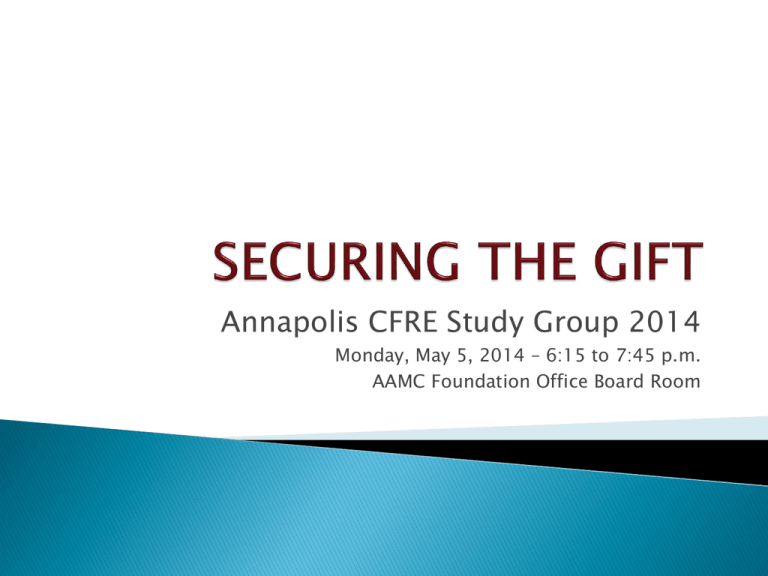
Annapolis CFRE Study Group 2014 Monday, May 5, 2014 – 6:15 to 7:45 p.m. AAMC Foundation Office Board Room This presentation takes for its outline the elements noted in “Module 5 of the AFP Fundamentals of Fundraising Course.” There are 7 key discussion areas noted in the above Module. Spend 10 minutes on each. Spend the remaining 15 minutes on Learning Styles with Wendy and then wrap up. Once the development plan is in place and appropriate policies and procedures are set up, it's time to actively solicit gifts from donors and prospects. In this module, a closer look will be taken at solicitation strategies for campaign types, focusing most closely on solicitation techniques for annual giving. Additionally, there will be an overview of techniques for soliciting major and planned gifts. Special emphasis will be placed on implementing critical acknowledgement, acceptance, and recognition practices. Objectives: After this module, you'll be better able to: 1. Describe solicitation techniques used in annual giving programs. 2. Identify, recruit, and prepare the appropriate mix of volunteers, staff, and professionals to carry out solicitations 3. Name the additional training needs for volunteers involved in solicitation. 4. Discuss the six steps to a "model" major-gift solicitation. 5. List strategies for obtaining support from corporations/businesses, foundations, and government entities. 6. Describe the process for developing and presenting a written grant proposal. 7. Discuss application of appropriate acknowledgement, acceptance, and recognition policies and practices. These are the vital funds an institution must raise to pay for ongoing operations. Usually, it’s “Unrestricted” - giving the institution the greatest flexibility to leverage the gift where it is most needed. Could be seen as a not very “sexy” case for support story line…”I don’t want my money to just pay for the lights.” Doesn’t lend itself to being “Donor-Centric.” How can the donor see themselves in an annual fund gift that pays for operations? “I want to know my money is being directed to a specific program.” BUT, with the right communications plan, with the right donor-centric appealing story line, with the right ongoing and increasing donor engagement program/opportunities, the Annual Fund is respected, understood for its value as a critical source of unrestricted support, and willingly stewarded by “invested” donors. The ways in which we ask people/entities to financial commit to our organizations on an annual basis may include these types of techniques: Orchestrated Direct Mail Program addressing both the solicitation of new donors and renewing/upgrading donors. Telemarketing and Phonathons – may be best used with current donors for thank you/recognition efforts, donor renewal and upgrade; special project requiring immediate funding need – a “Call to action” mobilization effort. Online Giving – capturing website visitors through a call to action landing page, soliciting e-newsletter subscribers, e-mail special project solicitations etc. Membership and Donor Clubs – employed with like-minded constituents and those prospects that may be motivated by benefits and directing their gift to a particular cause. Face-to-Face Solicitation – could be one-on-one or within the context of a group such as being solicited for a gift at a political fundraiser. Special Events Ticket Sales and Sponsorships – many non-profits host annual galas, golf outings etc to raise annual funds or program specific funding needs. Corporate Engagement and Program Support – does not usually fall under the Annual Giving Program function, however corporations may be making annual fund gifts. Foundation and Government Grant Requests A “golden rule” that really works: Identify and recruit a volunteer(s) to personally assist in a request that have already made their own personal commitment at or above the amount being requested from the prospect. This way they can “testify” to the value of the “case for support” and talk about why they invested. And they can answer the prospect when he or she asks if they have given. Have a senior program officer to communicate the “Case for Support.” They are the end-users of the donor’s gift. Building this relationship is invaluable to both new and upgraded giving by the donor. You may want your CFO on the solicitation team to offer further financial credibility to the request. From a CFRE Study Flashcards: Fundraisers who already have stature in other areas, and whose opinion is considered more objective tan that of an organization’s employees, can be extremely successful. Be careful to not overwhelm a prospect or prospect couple with too many players in the room. The more people in the room the less likely the prospect will be to open up to you for a genuine dialogue. If you, the professional fundraiser train, brief, and prepare the solicitation team properly i.e. a volunteer leader, a program officer, and say the CEO or CFO, you do not need to be in the meeting - just be ready to support, de-brief and conduct all the follow up work as needed. 4 Closing the Gift 1 Preparation 3 Handling Responses 2 Solicitation Volunteer solicitors should be well versed in the “case for support” and will need to be coached so that they can answer questions about the case. A biographical, professional and community engagement profile of the prospect should be provided to the volunteer solicitor that includes most importantly any information that may tie the prospect socially/ professional to the volunteer solicitor. This information is invaluable to establishing rapport and trust between the volunteer and prospect AND will make the volunteer feel much more comforatable. A formal Solicitation briefing/script should be provided to the volunteer solicitor and team notating the objectives of the meeting, the role of each member of the solicitation team is to play, and a script that can be followed to initiate and get to the “ask.” Role-playing and one-on-one training is critical to empowering volunteer solicitors in handling objections, negative reactions from the prospect. Through pre-solicitation meeting interactions among the solicitation team members and the professional fundraiser, possible scenarios can be discussed and possible responses can be developed and ready to communicate. Re-read case statement and prospectus/proposal Conduct prospect research ◦ Study Donor profile Understand campaign facts Understand specific proposal Know, “What Am I Asking for?” Visit preferably in pairs Clearly state gift’s impact Rehearse and practice your “Ask” Practice “with your partner”: ◦ Rehearse and role play ◦ Anticipate possible objections (and responses) ◦ Decide who says/does what ◦ The “ASK” I’m going to ask you to do three things: 1 Stretch your giving 2 Reach out Help us reach out to others specific individuals (as well as hosting our cohosting events) 3 Feel good “___work is very important, do the best you can, and feel good about your gift” Support your annual fund as well as give a capacity-giving gift Most important part of the solicitation Don’t apologize for asking Be clear, honest and deliberate Direct call to action Ask for a specific gift Most critical point of meeting Write it out Memorize it Don’t deviate Is it a closed question? Is it simple? Is it specific? Are you clear in what you are asking? ◦ How will you break it down? Request for more information Ask questions to clarify their concern Answer or reframe their question Trial close “Help me understand why” “Why do you feel that way?” “Please clarify that for me?” “What specific question or concern do you have about the campaign or ____?” “If money weren’t the issue, what other concerns or questions do you have?” GROUP DISCUSSES GROUP DISCUSSES GROUP DISCUSSES
